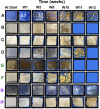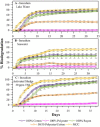Degradation of Cellulose Derivatives in Laboratory, Man-Made, and Natural Environments
- PMID: 35763720
- PMCID: PMC9277587
- DOI: 10.1021/acs.biomac.2c00336
Degradation of Cellulose Derivatives in Laboratory, Man-Made, and Natural Environments
Abstract
Biodegradable polymers complement recyclable materials in battling plastic waste because some products are difficult to recycle and some will end up in the environment either because of their application or due to wear of the products. Natural biopolymers, such as cellulose, are inherently biodegradable, but chemical modification typically required for the obtainment of thermoplastic properties, solubility, or other desired material properties can hinder or even prevent the biodegradation process. This Review summarizes current knowledge on the degradation of common cellulose derivatives in different laboratory, natural, and man-made environments. Depending on the environment, the degradation can be solely biodegradation or a combination of several processes, such as chemical and enzymatic hydrolysis, photodegradation, and oxidation. It is clear that the type of modification and especially the degree of substitution are important factors controlling the degradation process of cellulose derivatives in combination with the degradation environment. The big variation of conditions in different environments is also briefly considered as well as the importance of the proper testing environment, characterization of the degradation process, and confirmation of biodegradability. To ensure full sustainability of the new cellulose derivatives under development, the expected end-of-life scenario, whether material recycling or "biological" recycling, should be included as an important design parameter.
Conflict of interest statement
The authors declare no competing financial interest.
Figures













References
-
- Law K. L.; Narayan R. Reducing environmental plastic pollution by designing polymer materials for managed end-of-life. Nat. Rev. Mater. 2022, 7, 104–116. 10.1038/s41578-021-00382-0. - DOI
-
- Flury M.; Narayan R. Biodegradable plastic as an integral part of the solution to plastic waste pollution of the environment. Curr. Opin. Green Sustain. Chem. 2021, 30, 100490.10.1016/j.cogsc.2021.100490. - DOI
-
- Bauchmüller V.; Carus M.; Chinthapalli R.; Dammer L.; Hark N.; Partanen A.; Ruiz P.; Lajewski S.. BioSinn: Products for which biodegradation makes sense; Nova Institute, 2021.
Publication types
MeSH terms
Substances
LinkOut - more resources
Full Text Sources

